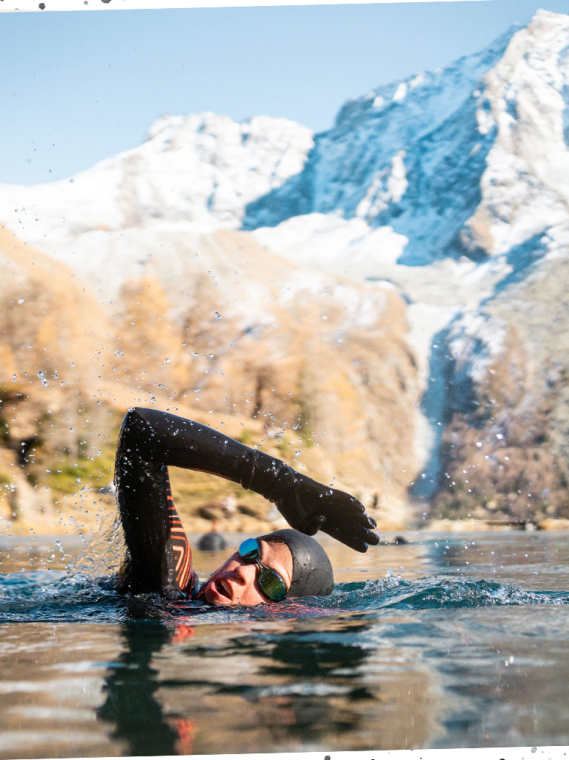
Keeping us warm in the cold
November 20, 2023 | 10 reading min.
The new Zeal Thermal, with the best thermal insulation in the range and superior flexibility, allows you to extend the open water season.
A guide to using neoprene accessories for enjoying cold winter water

The coldest months of the year are often those which require the most effort and diversity for sports, where snow becomes a playground during the winter season. It’s this time of year when outdoor activities require numerous layers for enjoyable sports that only cold weather can provide. This same logic applies to people who are passionate about water sports and wanting to enjoy the ocean even when temperatures drop.
Proper equipment not only allows you to continue enjoying outdoor environments, such as water, but also enables you to reap the benefits of swimming in cold water. Spending time in cold temperatures stimulates your mind, improves your sleep, activates your immune and lymphatic systems, and improves your general physical condition and mood.
But…where do you start?
Choosing neoprene gear—the equipment that covers and protects your skin—is undoubtedly one of the first lines of defense. Neoprene is a hi-tech material that conserves body heat efficiently without limiting mobility in the water. This is achieved in two ways: using technologies that maximize heat retention and other technologies that limit water entry.
The Zeal Thermal and Vitalis Thermal open water wetsuits are built for cold water swimming. Both are equipped with a sealing technology called “batwing” that consists of a second layer of neoprene in the zipper and neck area and limits the entry of water. The Zeal Thermal boasts the maximum thermal comfort of the Orca range, thanks to the Thermal X2 interior, and the thick panels of the Yamamoto 40+ enhance buoyancy without restricting flexibility and movement. The Vitalis Thermal neoprene completes the range and also features Thermal X technology, sharing a philosophy in terms of combining thermal comfort, buoyancy and comfort for the swimmer.
Complementary wetsuit accessories make a big difference for cold water swimming. Depending on your activity and the water temperature, we recommend accessorizing your wetsuit to enjoy your swim to the fullest.

Neoprene base layers allow you to stay active in very cold temperatures by adding extra protection. For those who prefer one-piece base layers, the Thermal Undersuit, a 2mm layer from Yamamoto, provides the necessary thermal protection for longer sessions without compromising your freedom of movement in the water.
If you prefer a single independent layer that protects the chest, Heatseeker neoprene vests are the alternative. This 2mm layer can be worn directly under the neoprene wetsuit. If water temperatures are extremely low, the Heatseeker vest with an integrated Thermal hood is the best option. But if it’s not that cold? A Base Layer neoprene t-shirt offers a boost of extra thermal comfort.
“Head, hands and feet.” To protect yourself from the cold, it’s imperative to take into account any part of the body that’s exposed to the elements. For this, neoprene accessories become great allies. Grab a hood, gloves and booties and get going!

The head is one of the most sensitive body parts to changes in temperatures. To protect it in the water, choose between a hood or a neoprene cap depending on your needs and the environment in which you’re swimming.
For hands and feet, there are two options: gloves and booties, available from Orca in two models.
It is as important to equip yourself for cold-water swims as it is to equip yourself for exiting the water. As your body continues to cool down back on land, it’s critical to warm up as soon as you leave the water. Wearing a poncho when changing out of your wetsuit is ideal, as is bundling up in a long thermal jacket like the Thermal Parka and drinking a hot drink. Once you’re warmed back up, it’s time to bask in the joy of completing another successful session in the ocean.

November 20, 2023 | 10 reading min.
The new Zeal Thermal, with the best thermal insulation in the range and superior flexibility, allows you to extend the open water season.

October 30, 2023 | 10 reading min.
Swimming in cold water and doing it in a different spot for thirty days, Aaron's Rolph interseason challenge.

November 8, 2022 | 5 reading min.
The best lakes and rivers for open water swimming in Snowdonia, North Wales.